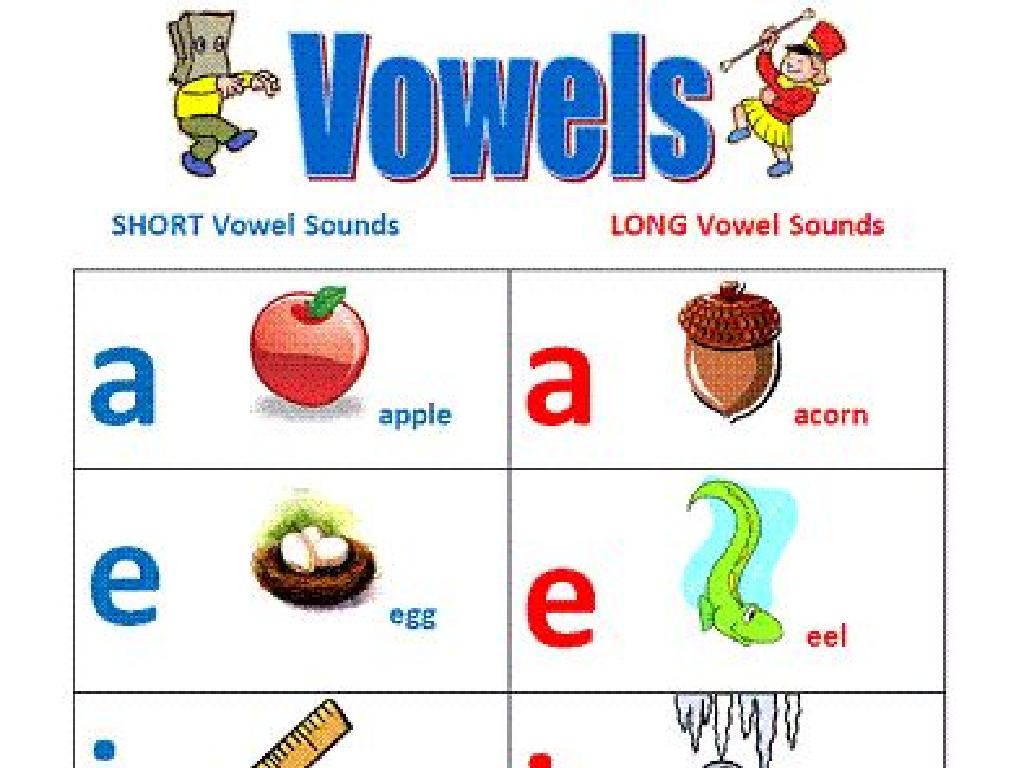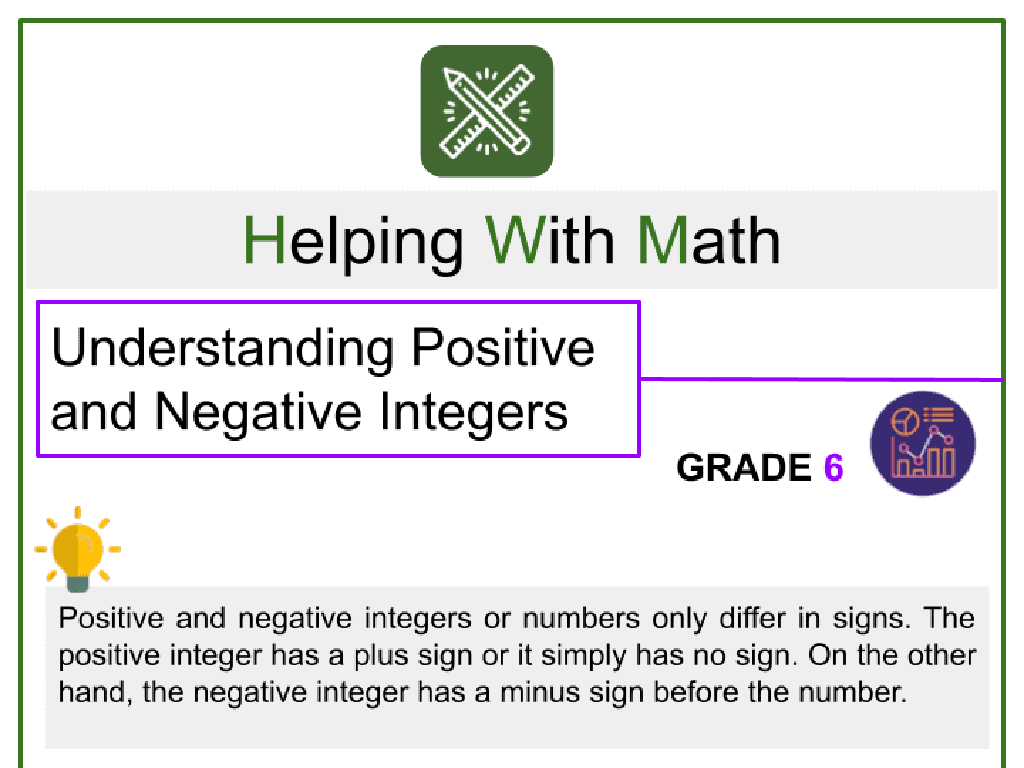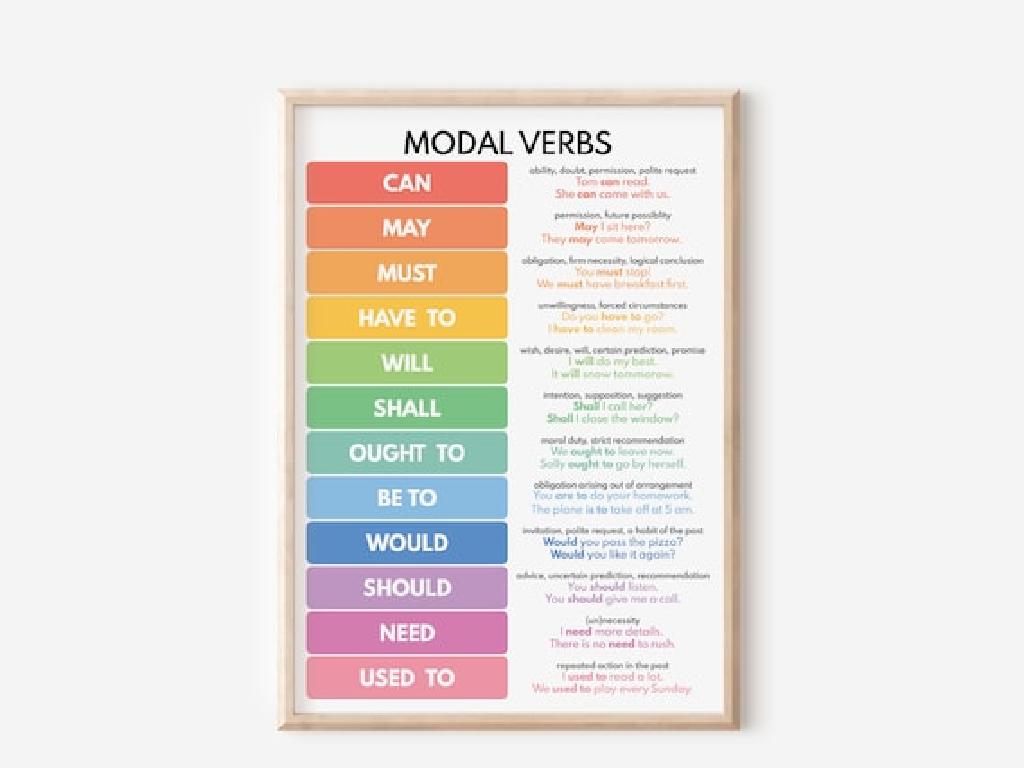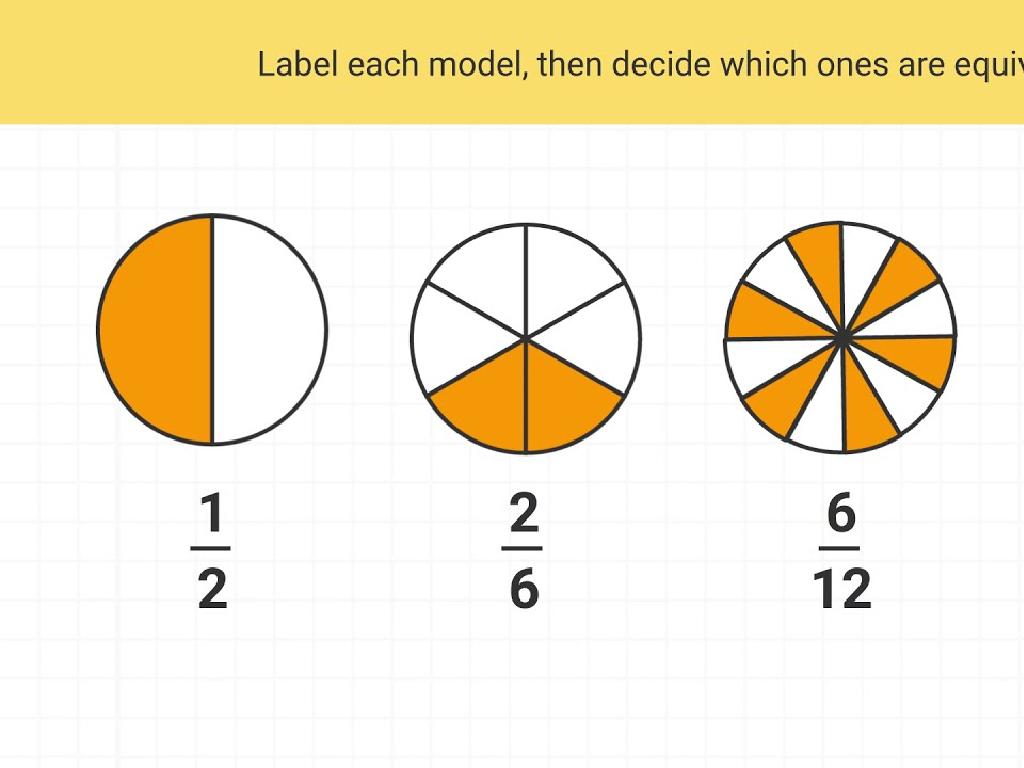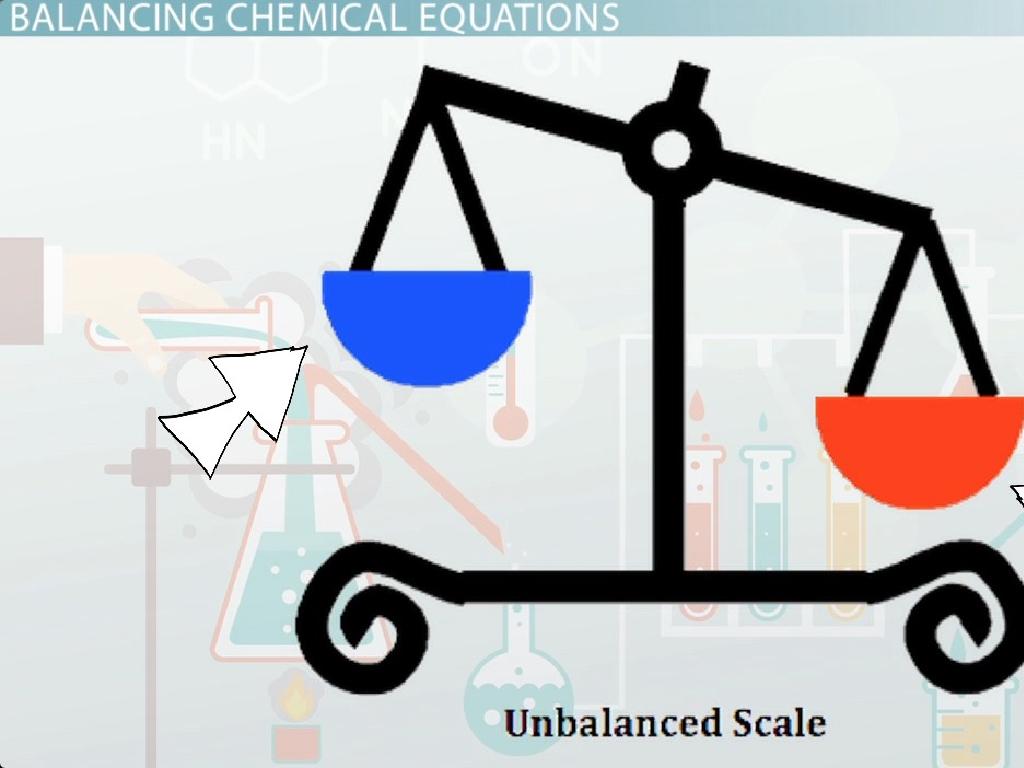Sort By Initial Consonant Blend Or Digraph
Subject: Language arts
Grade: Second grade
Topic: Consonant Blends And Digraphs
Please LOG IN to download the presentation. Access is available to registered users only.
View More Content
Consonant Blends and Digraphs
– Learn about blends and digraphs
– Blends are two letters that make a combined sound, like ‘bl’ in ‘black’.
– Sort words by initial sounds
– Digraphs are two letters that make one sound, like ‘sh’ in ‘ship’.
– Understand importance for literacy
– Recognizing these helps with reading new words and spelling.
– Practice sorting with examples
– We’ll sort words like ‘snack’ (sn-) and ‘chair’ (ch-) together.
|
This slide introduces the concept of consonant blends and digraphs to second graders, which are crucial phonetic components of English literacy. Blends involve two consonants where each letter’s sound is still heard, while digraphs combine two letters to produce a single, distinct sound. Understanding these will aid students in decoding unfamiliar words during reading and provide a foundation for accurate spelling. Engage the class with interactive sorting activities where they categorize words based on their initial sounds, reinforcing their ability to distinguish between blends and digraphs. This practical application solidifies the lesson and prepares them for more advanced reading and writing tasks.
Exploring Consonant Blends
– What are consonant blends?
– When 2 or more consonants make a sound together, like ‘st’ in ‘stop’.
– Examples: bl, cr, sp, gr
– ‘bl’ as in ‘black’, ‘cr’ as in ‘crisp’, ‘sp’ as in ‘spoon’, ‘gr’ as in ‘green’.
– Each sound is distinct
– You can hear each consonant’s sound clearly in the blend.
– Practice listening to blends
– We’ll listen to words with these blends to hear each letter.
|
This slide introduces the concept of consonant blends to second graders. Consonant blends occur when two or more consonants are combined and each consonant’s sound can be heard in the blend. Provide examples of common consonant blends and ensure that students understand that unlike digraphs, each consonant in a blend maintains its original sound. Engage the class by listening to words that contain these blends and practicing saying them together. This will help students recognize and pronounce blends correctly. Encourage students to come up with more examples and share them with the class.
Exploring Consonant Digraphs
– What are consonant digraphs?
– Two consonants combine to make one sound
– Examples: ch, sh, th, wh
– ‘ch’ as in chair, ‘sh’ in ship, ‘th’ in thumb, ‘wh’ in whale
– Digraphs vs. blends
– Blends are two letters that make two sounds; digraphs make one
– Practice with digraphs
|
Introduce the concept of consonant digraphs by explaining that unlike blends, where each letter maintains its own sound, digraphs merge two consonants to produce a single, distinct sound. Use common examples like ‘ch’, ‘sh’, ‘th’, and ‘wh’ to illustrate this concept. Make sure to clarify the difference between blends and digraphs, as this can be a common point of confusion. Engage the class with practice examples, asking them to identify digraphs in words you provide or from their reading. This will help solidify their understanding of how digraphs function within words.
Sorting Words by Initial Blends
– Understanding initial blends
– Initial blends are the first two letters in words that make a unique sound.
– Sorting words activity
– We’ll sort words by their starting sounds.
– Examples: block, crab, spin, green
– ‘bl’ in block, ‘cr’ in crab, ‘sp’ in spin, ‘gr’ in green.
– Practice sorting with classmates
|
This slide introduces the concept of initial consonant blends to second graders. Begin by explaining that blends are combinations of two letters that make a single sound when pronounced together. Use the examples provided to illustrate how each word starts with a different blend. Encourage the students to say the words out loud to hear the initial blend. After explaining, engage the students in a sorting activity where they work with classmates to sort a list of words based on their initial blends. This interactive approach helps reinforce their understanding of the concept and allows them to practice phonics skills in a collaborative setting.
Sorting Words by Initial Digraphs
– Digraphs: two letters, one sound
– Examples: ‘ch’ in chair, ‘sh’ in ship
– Sort words by first two letters
– Example words: chair, ship
– ‘ch’ as in chair, ‘sh’ as in ship
– Practice sorting: thumb, whale
– ‘th’ as in thumb, ‘wh’ as in whale
|
This slide introduces the concept of initial digraphs to second-grade students. Digraphs are pairs of letters that come together to make a single sound, such as ‘ch’ in ‘chair’ or ‘sh’ in ‘ship’. The activity involves sorting a given list of words by their initial digraphs. Encourage the students to say the words out loud to hear the initial sounds. Provide guidance on how to identify the digraphs and sort the words accordingly. For the class activity, students can work individually or in groups to sort additional words by their initial digraphs. This exercise will help reinforce their understanding of digraphs and improve their phonetic skills.
Practice Time: Sorting Blends & Digraphs
– Sort words by initial blends
– Blends: two letters, one sound like ‘bl’ in block
– Sort words by initial digraphs
– Digraphs: two letters, one new sound like ‘ch’ in chair
– Group activity on the board
– Practice makes perfect!
|
This slide is meant for a hands-on class activity where students will practice sorting words based on their initial consonant blends and digraphs. Start by explaining the difference between blends and digraphs. Blends are where you can hear both consonants together, while digraphs combine to make a new sound. Use the board to demonstrate with examples, then invite students to come up and try sorting words themselves. Provide a list of words for them to sort and encourage them to say the sounds out loud as they work. This will help reinforce their understanding of the concept. Possible activities could include sorting flashcards, creating a chart on the board, or matching words to pictures that illustrate the blends and digraphs.
Let’s Play a Game: Blends and Digraphs!
– Match words to blends/digraphs
– Pair up for the challenge
– Find a classmate to work with
– Count your correct matches
– Keep track of how many you get right
– Have fun learning together!
– Learning is fun with friends
|
This interactive game is designed to help students recognize and understand initial consonant blends and digraphs. By working in pairs, students will engage in a matching activity where they connect words to their corresponding initial blends or digraphs. Provide a list of words and a separate list of blends and digraphs for students to match. Encourage them to say the words out loud to hear the initial sounds. This activity fosters cooperative learning and reinforces phonics skills. As a teacher, circulate the room to assist and assess understanding. Possible variations of the activity could include a timed challenge, a competition between pairs, or creating a poster with their matches to display in the classroom.
Class Activity: Blend and Digraph Hunt
– Let’s hunt for blends and digraphs
– Find objects or pictures in class
– Look for things starting with ‘bl’, ‘cl’, ‘fl’, etc.
– Write down the words you discover
– Use your detective skills to spot tricky digraphs like ‘ch’, ‘th’, ‘sh’
– Share your findings with everyone
|
This interactive activity is designed to help students recognize and understand initial consonant blends and digraphs in a fun and engaging way. Set up the classroom with various objects and pictures that start with different blends and digraphs. Encourage students to explore the room and find as many examples as they can. Provide them with a worksheet to write down the words they find. After the hunt, gather the students and have them share their findings, reinforcing their understanding of blends and digraphs. Possible variations of the activity could include a timed challenge, team competitions, or creating a classroom display with the collected words.
Sorting Blends and Digraphs: Review
– Blends have distinct sounds
– Like ‘bl’ in block or ‘st’ in stop
– Digraphs: two letters, one sound
– Like ‘sh’ in ship or ‘ch’ in chair
– Practice makes perfect
– Let’s recap our word hunt
– Share the words you found and sorted
|
As we conclude today’s lesson, let’s go over the key points. Blends are a combination of letters where each consonant’s sound can be heard, such as ‘bl’ in ‘block’ or ‘st’ in ‘stop’. Digraphs, on the other hand, consist of two letters that together make a single sound, like ‘sh’ in ‘ship’ or ‘ch’ in ‘chair’. Encourage the students to keep practicing by identifying blends and digraphs in words they encounter in their reading. To wrap up, have students share the words they found during the word hunt activity and discuss the blends and digraphs in those words. This review solidifies their understanding and prepares them for more advanced reading skills.

